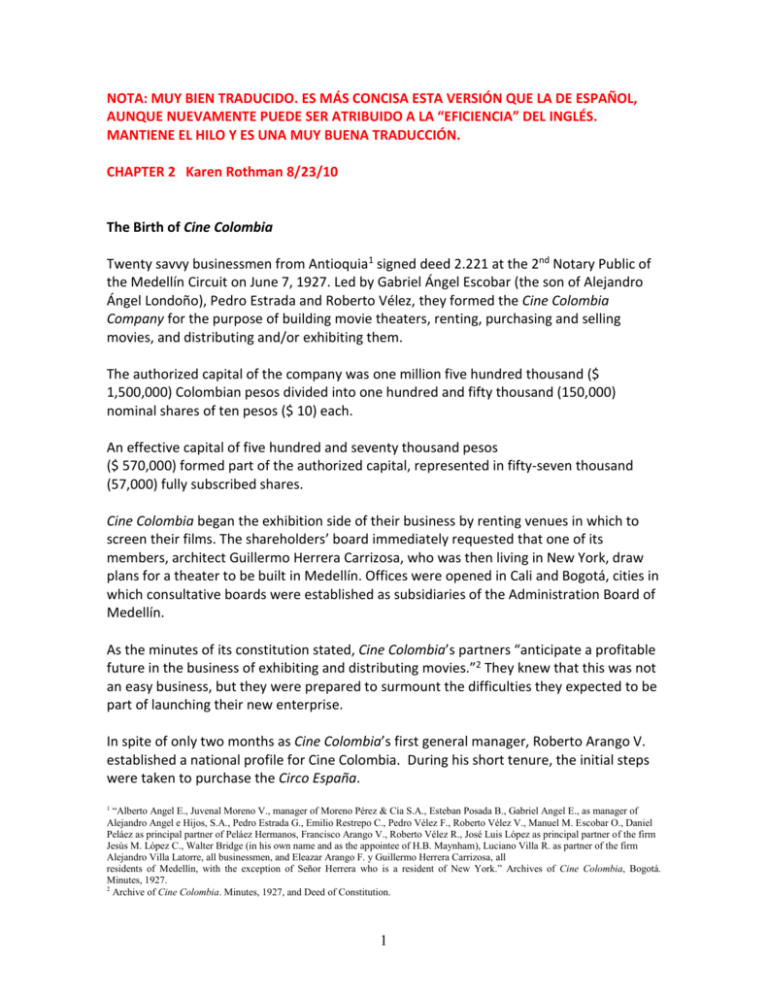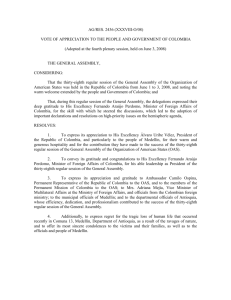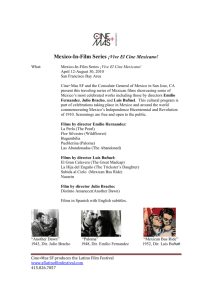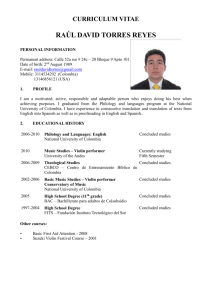Chapter 2
advertisement

NOTA: MUY BIEN TRADUCIDO. ES MÁS CONCISA ESTA VERSIÓN QUE LA DE ESPAÑOL, AUNQUE NUEVAMENTE PUEDE SER ATRIBUIDO A LA “EFICIENCIA” DEL INGLÉS. MANTIENE EL HILO Y ES UNA MUY BUENA TRADUCCIÓN. CHAPTER 2 Karen Rothman 8/23/10 The Birth of Cine Colombia Twenty savvy businessmen from Antioquia1 signed deed 2.221 at the 2nd Notary Public of the Medellín Circuit on June 7, 1927. Led by Gabriel Ángel Escobar (the son of Alejandro Ángel Londoño), Pedro Estrada and Roberto Vélez, they formed the Cine Colombia Company for the purpose of building movie theaters, renting, purchasing and selling movies, and distributing and/or exhibiting them. The authorized capital of the company was one million five hundred thousand ($ 1,500,000) Colombian pesos divided into one hundred and fifty thousand (150,000) nominal shares of ten pesos ($ 10) each. An effective capital of five hundred and seventy thousand pesos ($ 570,000) formed part of the authorized capital, represented in fifty-seven thousand (57,000) fully subscribed shares. Cine Colombia began the exhibition side of their business by renting venues in which to screen their films. The shareholders’ board immediately requested that one of its members, architect Guillermo Herrera Carrizosa, who was then living in New York, draw plans for a theater to be built in Medellín. Offices were opened in Cali and Bogotá, cities in which consultative boards were established as subsidiaries of the Administration Board of Medellín. As the minutes of its constitution stated, Cine Colombia’s partners “anticipate a profitable future in the business of exhibiting and distributing movies.”2 They knew that this was not an easy business, but they were prepared to surmount the difficulties they expected to be part of launching their new enterprise. In spite of only two months as Cine Colombia’s first general manager, Roberto Arango V. established a national profile for Cine Colombia. During his short tenure, the initial steps were taken to purchase the Circo España. “Alberto Angel E., Juvenal Moreno V., manager of Moreno Pérez & Cía S.A., Esteban Posada B., Gabriel Angel E., as manager of Alejandro Angel e Hijos, S.A., Pedro Estrada G., Emilio Restrepo C., Pedro Vélez F., Roberto Vélez V., Manuel M. Escobar O., Daniel Peláez as principal partner of Peláez Hermanos, Francisco Arango V., Roberto Vélez R., José Luis López as principal partner of the firm Jesús M. López C., Walter Bridge (in his own name and as the appointee of H.B. Maynham), Luciano Villa R. as partner of the firm Alejandro Villa Latorre, all businessmen, and Eleazar Arango F. y Guillermo Herrera Carrizosa, all residents of Medellín, with the exception of Señor Herrera who is a resident of New York.” Archives of Cine Colombia, Bogotá. Minutes, 1927. 2 Archive of Cine Colombia. Minutes, 1927, and Deed of Constitution. 1 1 KR 8/23/10 On August 9, 1927, the first shareholders’ meeting was held to accept the resignation of Arango and to elect his replacement, Fernando Isaza, a well-known lawyer from Medellín. Isaza took the reins of the company3 and speeded up the process of listing Cine Colombia on the Medellín stock exchange as a corporation or share company (the equivalent of a limited company today). On September 21, 1927, Cine Colombia stock was made available, and was included in the “Corporate Stock Market Section” published daily by stockbroker Alejandro Villa Latorre. 4 Having achieved this fundamental first step, Isaza focused on establishing Cine Colombia’s preeminence in Medellín through the purchase of Circo España, listed on the stock exchange as Compañía del Circo España. At first glance, it might have seemed impossible, as Circo España was one of the most profitable businesses there during the previous twenty years. However, with available capital totaling $ 1,500,000, Isaza made the Compañía del Circo España an offer its shareholders could not refuse. As soon as Elías Gómez, the company’s manager, formally accepted it, the board of Cine Colombia met and approved the sale of six thousand shares to finance the purchase of the old bullring. On September 28, 1927, the transfer of Circo España to Cine Colombia was accomplished, and as of October 14, the Compañía del Circo España ceased to exist among the companies listed on the stock exchange.5 Fernando Isaza then turned his attention to his next major goal: to acquire Belisario Díaz’ company. This was an important Colombian distributor and exhibitor, which owned a number of silent movies produced between 1923 and 1926, as well as Cartagena’s Rialto Theater. Another asset of The Belisario Diaz Company was the relations the company had established with the proprietors of movie venues throughout the country. After purchasing the Belisario Díaz Company, Isaza scored another major accomplishment: he leased the exclusive Junín Theater. The Junín had produced excellent profits for its two current tenants, the Di Domenico brothers and Belisario Díaz. Isaza offered Gonzalo Mejía, the theater’s proprietor, a higher rent than he was then receiving. After November 11, 1927, the Junín Theater exhibited only the movies distributed by Cine Colombia. _____________________ 3 Cine Colombia, Archive. Minutes, 1927 4 El Colombiano, Medellín, September 22, 1927, pag. 2. 5 El Colombiano, Medellín, October 14, 1927, p. 4 2 KR 8/23/10 The Di Domenico brothers continued to compete with Cine Colombia in Medellín by exhibiting their movies at the Bolívar Theater. Cine Colombia screened its movies in the Circo España and the Junín Theater. Its movie schedule was published in clever daily advertisements in Medellín’s newspapers. The year 1927 came to a close with only two competitors left in the field of film distribution in Colombia: the Di Domenico Brothers and Cine Colombia. Fernando Isaza, and the Board of Directors of Cine Colombia, including Roberto Vélez V., Manuel M. Escobar O., Daniel Peláez R., Jesús M. López, Eduardo Restrepo, and Gabriel Angel E. as adviser, continued their drive to expand the company in 1928. They undertook one of the largest transactions of the time by acquiring the entire enterprise of the Di Domenico brothers, including its huge inventory of movies and several theaters throughout the country. The acquisition was made for the sum of one million two hundred and fifty thousand pesos ($1,250,000). This deal made it absolutely clear that Cine Colombia intended to become the main force in developing the national movie market. The next step was renting the capital city’s principal movie theater, the Olympia, owned by a group of investors from Bogotá who had previously bought it from the Di Domenico brothers. The company also made an agreement to rent the Colombia Theater in Cali, and another deal to manage the large and elegant Faenza Theater in Bogotá. By the close of the 1920’s, seven theaters were operating at full capacity in the capital city. 6 Incredibly, this growth occurred despite an total absence of newspaper advertisements for movies in Bogotá. The opposite occurred in Medellín, however. Cine Colombia placed daily advertisements in the city’s two newspapers, yet the four theaters there7 were only half filled, and no movie lasted more than a day. The very few exceptions included the films starring the actress Bebé Daniels,8 the action and suspense series El Arquero Verde (in ten episodes) and the spectacular production, Ben Hur. By this time, Cine Colombia had forged strong business relations with theater owners at the national level, as well as with the large American studios in New York: Metro, Paramount, First National and United Artists. These relationships extended to European production houses, as well, including Pathé in Paris and Ufa in Berlin. These important alliances made it possible for Cine Colombia to import a wide variety of films, many of them 3 KR 8/23/10 premieres. The public came to expect diverse, quality entertainment from Cine Colombia. Cine Colombia built a repertoire of quality movies and box-office hits. One of them, El Volcán, inaugurated the Thursdays of Art, so-called by the exhibitor to highlight the artistic quality of certain productions, today known as “alternative cinema.” El Volcán, featuring two of the greatest stars of the silent screen, Bebé Daniels and Ricardo Cortés, filled the Junín to the roof. The demand for tickets was so great that Cine Colombia had to replay it six times in the following months, which was a first for any film ever before screened in Medellín. But it was Ben Hur that smashed all records when it premiered in 1928, continuing for a fortnight with a full house at all three daily screenings. The marketing strategy that generated anticipation during the preceding two months culminated in a huge hit. The day before the premiere, the usual afternoon performance was canceled in the Junín in order to screen “the great work of Ben Hur” for Medellín’s intelligentsia. Box-office sales surpassed even the most optimistic forecasts. The plans designed by Guillermo Herrera Carrizosa, the architect and partner of Cine Colombia, were completed, and the company was ready to build its first movie theater in Medellín in 1928. The first name chosen for it was Guayaquil Theater,9 but, as construction progressed, its name was changed to Granada Theater, with which it opened on July 7, 1931. Support for National Production An essential part of the mission that drove the founders of Cine Colombia was to stimulate and promote the production of national cinema, and to distribute Colombian-made films. Such was the case of Tuya es la Culpa, a Colombo-Italian co-production that was filmed in Cali in 1926, starring the Italian actress, Mara Meba, and directed by the Italian, Camilo Cantinazzi. The script was written by a Colombian, Elías Quijano, the director of photography was Joaquín Salcedo, also a Colombian, and the camera operator was an Italian named Silvio Cavazoni. It was produced by the Colombia Films Company. In 1927, several businessmen from Antioquia invested capital to create a movie production company, Bolívar Films S.A. They commissioned Rubén Arcila, a partner of the firm, to produce the first movie. The plot revolved around the life of Rafael Uribe Uribe, one of the most important men in all the history of Antioquia. Rubén Arcila recruited the writing talents of Efe 4 KR 8/23/10 Gómez, who completed a script entitled Rafael Uribe Uribe (or the End of the Civil Wars in Colombia)in early 1928. Under the direction of Pedro J. Vásquez, the filming began production at the end of April. In June a publicity campaign was launched to create public anticipation. It continued until the 21st of December, when the first part of the film on Uribe Uribe premiered in Medellín. Cine Colombia did not participate in Bolívar Films S.A., nor contribute to financing the movie. None-the-less, they premiered Rafael Uribe Uribe in their two theaters in Medellín, the Junín and the Circo España. Both theaters were full for the two days of its exhibition, Thursday the 21st and Friday the 22nd of December, 1928. But, as with the documentary of 1915, the 1928 version became the object of a bitter controversy. Efe Gómez, the film’s scriptwriter was a liberal, and the story line was offensive to the conservatives, who were in power in Colombia at that time. There was enormous negative influence leveled by the Catholic Church, whom Uribe Uribe had opposed in the civil wars of 1885, 1898 and 1899-1902, and in the post-war years. Once again, these powerful groups aligned in their attacks on the film. Cine Colombia decided to cease exhibition of the film in its theaters because the conservatives’ protests ended with the destruction of some of the Junín’s seats during the second screening on Friday. Perhaps the intensity of their emotions was fanned by the 1930 presidential electoral race. On completion of the filming of the second part of this movie on Uribe Uribe, the board of Cine Colombia reconsidered its initial decision not to exhibit it. Although approval was granted for it to be shown nationally in the company’s theaters, its agents were advised, “that it was their responsibility to refrain when the theater owner’s propaganda for the movie became exaggerated; that they clarify to the audience that the movie does not belong to Cine Colombia; and that they make the owner of the movie responsible for any damages that might occur in some theaters as a result of its screening.”10 6 Olympia, Faenza, Bogotá, Municipal, Cinerama, Real y Caldas. Junín, Bolívar, Rialto and Circo España. 8 Bebé Daniels (1901 – 1974), one of the most sought-after actresses of the silent era, and who made a successful transition to talking movies, was the granddaughter of a Colombian woman, Eva Plaza, from Buga (Department of Valle), who married the American Consul in Medellín, a veteran of the Civil War, General George Butler Griffin, and gave birth to several girls. General Griffin took his family to live in California. The eldest of these girls was the mother of Bebé Daniels. Susana the Detective, played by Daniels, was one of the public’s favorite characters for many years. 7 9 Cromos, Bogotá, December 22, 1928. 10 Archives of Cine Colombia. Minutes of the Board, 1929. 5 KR 8/23/10 Civic Responsibility From its inception, Cine Colombia had a policy of social and civic responsibility. The board convened on September 4, 1928, to approve an allocation of capital in the amount of two million pesos divided, in two hundred thousand shares of $10 each, dedicated to benefit projects outside of the company’s usual business. For example, the board members sanctioned support for a civic campaign to raise funds for a paving and drainage project in Medellín. The September 24 editions of Medellín’s two newspapers devoted eighty per cent of their advertising space to the campaign, “Paving and Drainage, a Prime Necessity for Medellín.” One of the advertisers who donated its space was Cine Colombia. The company also projected slides promoting the project in their theaters gratis, as well as contributed funds to it directly. A Precarious Time When Cine Colombia started its business, talking movies had just appeared in the United States. The Jazz Singer, the first “talkie,” made possible by new technological advances, was exhibited in public on October 6, 1927. The commercial penetration of talking movies was gradual. Once their entertainment value became evident to the exhibitors, they were obliged to outfit their theaters to accommodate sound. Of course, considerable investments were necessary to make the required changes to the projection equipment, and to buy new equipment for sound. As this worldwide transition to sound was taking place, a strong competitor to Cine Colombia appeared in the city of Cali. The Compañía Cine Bolívar, set up by a powerful U.S. investment house, had urbanized a barrio in the city and rented the Municipal Theater to exhibit the latest movies being released by the different American studios. Cine Bolívar set about expanding its radius of commerce to include the same cities where Cine Colombia distributed and exhibited its movies. Cine Colombia did not ignore this threat. In January, 1929, the board in Medellín commissioned Nicolás Díaz, its agent in Bogotá, to purchase two large nineteenth century houses between Calles 23 and 24 with Carrera 7. Their plan was to raze the buildings and to use the land to construct Cine Colombia’s first movie theater in the capital city. A public contest was held to select the design for the theater. 6 KR 8/23/10 A greater threat to Cine Colombia appeared in the third quarter of 1929 when Cine Bolívar screened the first talking movies in Colombia. The Board of Directors and Talking Movies The board meeting of April 15, 1929, was presided over by Roberto Vélez V, and attended by members Daniel Peláez and Alejandro Ángel Escobar, general manager Fernando Isaza, and Secretary Manuel M. Escobar. A cable sent from Paris by Gabriel Ángel Escobar was read into the minutes. It contained news from a report by Echavarría Inc., Cine Colombia’s international consulting firm, stating that Metro, Paramount and First National wanted Cine Colombia to agree to license talking movies from them. It also stated that the Compañía Cine Bolívar had already completed negotiations to acquire talking movies from Fox, and was preparing to negotiate with other production companies. Gabriel Ángel was wary of rushing Cine Colombia into involvement with talking movies, believing their commercial value was unproven. He didn’t want the board to make a decision in reaction to pressure felt from the producers and the competition. Ángel advised the board members to thoroughly research the subject before making a decision. The general manager, Fernando Isaza, on the contrary, believed that Cine Colombia should embark on an immediate transition into talking movies. He believed that delaying in order to evaluate how the competition fared would likely put Cine Colombia at a disadvantage. Echavarría Inc.’s report, dated March 29, 1929, concerning the activities of the Compañía Cine Bolívar in New York, advised that action was required: the New York production houses with which Cine Colombia did business were demanding a decision. The report pointed out the obvious threat posed by Compañía Cine Bolívar. The board decided to postpone a final decision until Gabriel Ángel could go to New York to investigate. But, a few weeks later, he cabled from Paris that he was unable to make the trip. Fernando Isaza reported to the board that Cine Bolívar was building a new theater in Cali, that they had already rented the Municipal Theater in the same city, and that they had rented the Municipal Theater of Popayán, as well. They were also acquiring theaters in the Department of Valle del Cauca, according to a report by Cine Colombia’s agent in Cali. The 7 KR 8/23/10 general manager added the significant news that Cine Bolivar had purchased several Simplex sound projectors in New York. These events naturally provoked concern among the partners in attendance at the April 15, 1929 meeting. They recognized the alarm felt by their general manager, Fernando Isaza, as he raised further issues. He called the partners’ attention to the fact that sound and synchronized films had already penetrated the main cities of the United States. In his opinion, it was inevitable that they would displace silent cinema in Colombia. Isaza summarized his opinions regarding sound movies as follows: a) Cine Colombia could not prevent competitors from entering their market, since there were around forty production houses in the United States alone, as well as many smallscale production houses and distributors. Cine Colombia should ensure its continued relations with the main production houses. He foresaw the danger of allowing their competitors to make deals with Metro and Paramount. To avert this threat, Isaza recommended that Cine Colombia enter a similar deal as one recently closed with Pathé (French production company) whereby they would take a small quantity of talking movies, to be dispatched at the end of the year. The deal should give Cine Colombia the right to acquire more films of their choice, in the probable event of the rapid advancement of talking or synchronized movies in Colombia. The right of the company to exclusively introduce a producer’s talking movies could be included in the contracts. Of course, it necessitated that specialized equipment be obtained for this purpose. The general manager reminded the board what had happened to the Di Domenico Brothers when Cine Colombia bought the Belisario Díaz Company. By dominating the acquisition of the films made by the main American production houses Cine Colombia had expanded rapidly while causing the decline of their competitor. b) Although Isaza conceded that it was very difficult and costly to establish talking movies in Colombia, he believed it was necessary for Cine Colombia to do so. The real danger to the company was to allow a competitor to get a head start. This was a new business that would most probably make silent films obsolete. Isaza suggested sending someone knowledgeable about the business to New York to make a comprehensive study of talking movies, and to report back as to how to implement the required changes. The general manager voiced concern that he lacked sufficient technical knowledge to decide upon details wihtout further investigation. Still, he 8 KR 8/23/10 considered it imprudent to take no action while competitors were already studying the logistics in New York, and importing talking films into Colombia. The board deliberated the matter and accepted, in principle, the idea of sending someone to New York to study the issues. Unfortunately, a definitive course of action was left to be determined at a subsequent meeting, as was the selection of the individual to send should they decide to proceed with the recommendation.11 This later proved to be a regrettable, indeed. By not taking immediate action, the board indirectly abetted the competition, which began importing the equipment needed to exhibit talking movies into Colombia. Isaza’s warning about the danger of Cine Colombia being overtaken by the competition became an imminent reality. 11 Archive of Cine Colombia. Minutes of the Board, 1929. 9





